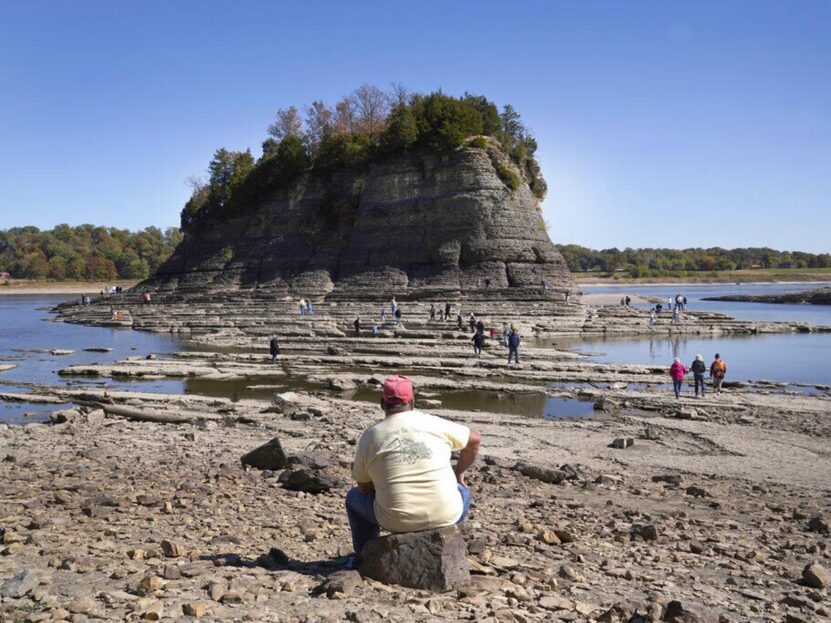The possibility of the Mississippi River drying up presents a dire scenario, blending ecological disaster with economic chaos. This vital artery of commerce and life has been experiencing record-low water levels, highlighting the intricate balance between the natural environment and human activities.
The diminished water levels, driven by insufficient rainfall and persistently warm, dry conditions, have triggered alarms in various sectors, including shipping and tourism, spotlighting the river’s essential role in the United States’ ecological and economic framework.
Key Takeaways
- Critical Role: The Mississippi River, crucial for commerce and ecology, faces threats from record-low water levels caused by drought, affecting shipping, tourism, and the U.S. economy.
- Biodiversity Risks: Covering 41% of the U.S., the Mississippi’s diverse habitats are at risk from droughts, necessitating urgent conservation efforts to maintain ecological balance.
- Economic and Health Impacts: Reduced water levels disrupt shipping and pose health risks through saltwater intrusion into Louisiana’s drinking water, demonstrating the link between environmental and economic health.
- Climate Change Effects: Severe weather events from climate change impact the river’s flow, requiring immediate action to counteract these effects, as emphasized by the river’s endangered status.
- Resilience and Action: While the Mississippi’s complete drying is improbable, current challenges call for urgent, science-based action to protect the river’s health, support livelihoods, and ensure environmental sustainability.
This huge area, where 41 percent of the U.S. drains into the Mississippi River, shows how nature connects and supports many living things. In the past, this area had a changing floodplain that made the land fertile and helped many ecosystems thrive when it rained a lot.
A Sanctuary for Biodiversity
In periods of drought, the river’s transformation into a series of pools becomes a lifeline for an astonishing variety of species. With 241 fish types, 50 mammal species, and 45 amphibian species finding refuge and sustenance in these waters, the river’s ecological significance cannot be overstated.
Migratory Pathways
Beyond its role as a habitat, the Mississippi River marks the rhythm of nature through its role as a migratory conduit for birds. These migrations, essential for the survival of many bird species, also signify the interconnectedness of ecosystems across the hemisphere, further underscoring the river’s importance in the broader ecological tapestry.
Are there Economic and Environmental Implications?
The recent plunge to record low water levels poses immediate and far-reaching economic threats. Communities that have thrived on the rhythm of the river now grapple with halted shipping operations, a critical component of the regional and national economy.
This standstill jeopardizes the seamless flow of goods, echoing through the supply chain and impacting everything from local employment to nationwide product availability and pricing.
The Saltwater Threat
Compounding the economic turmoil is a looming environmental health crisis. As saltwater encroaches from the Gulf of Mexico, the integrity of drinking water supplies for Louisiana and potentially beyond is at stake.
A Multitude of Risks
The interruption of river traffic and the looming threat of saltwater intrusion represent just the surface issues of a deeper crisis. These challenges underscore the delicate balance between human endeavors and the environment, emphasizing the critical importance of managing this essential resource sustainably.
The presence of pipelines in the Mississippi River introduces a layer of danger, compounding the complexity of ensuring the river’s health and safety.
Is Biodiversity at Risk?
The river’s biodiversity is teetering on the brink of a crisis. As habitats shrink and food sources become scarce, the survival of countless species hangs in the balance.
Ripple Effects Across Ecosystems
The potential collapse of the river’s ecosystems would have far-reaching consequences, affecting not just the species that directly inhabit the river but also those in connected habitats. The loss of a single species can have a domino effect, leading to unforeseen consequences across the ecological spectrum.
The Urgency of Conservation
In the face of these challenges, the imperative for conservation and sustainable management practices becomes clear. Protecting the river’s biodiversity is not just about preserving species but about maintaining the ecological balance that supports human and natural communities alike.
The driving force behind these environmental and economic crises is the undeniable impact of climate change. The increased prevalence of extreme weather events, from floods to droughts, is a clear signal of the shifting climate, directly affecting the Mississippi River’s flow and health.
A Call to Action
The designation of the Mississippi as one of America’s Most Endangered Rivers by American Rivers serves as a clarion call to address these issues head-on. It highlights the urgent need for concerted efforts to mitigate the impacts of climate change and adapt to its inevitable effects.
The Broader Implications
The challenges faced by the Mississippi River are a microcosm of the global struggle against climate change. They underscore the interconnectedness of human, animal, and environmental health, and the need for a unified approach to safeguarding our planet’s future.
What Would a Hypothetical Catastrophe Look Like?
The notion of the Mississippi River drying up entirely conjures images of widespread devastation, affecting everything from agriculture to energy production. This scenario, while extreme, serves as a powerful thought experiment, illuminating the potential consequences of inaction and complacency.
The Domino Effect
The cascade of effects that would follow the river’s complete desiccation—from crop failures to the collapse of power generation—highlights the intricate dependence of human systems on natural water sources. This hypothetical disaster underscores the vital importance of water management and conservation strategies.
A Call for Preparedness
This dire prediction emphasizes the need for preparedness, resilience, and, most importantly, a willingness to believe and act on scientific evidence. It is a reminder that, while the river’s complete drying up may be unlikely, the path we choose today will shape the challenges and opportunities of tomorrow.
What Is the Reality of The Mississippi’s Resilience?
While the complete drying up of the Mississippi River is an improbable scenario, given its vast drainage basin and historical resilience, it serves as a stark reminder of the river’s importance. A significant climate shift would be required to threaten its existence, highlighting the need for global climate action.
The Buffer of the Basin
The Mississippi’s extensive drainage basin acts as a natural buffer, ensuring the river’s flow even in the face of changing climatic conditions. This geographical and climatic safeguard provides a measure of security, but it is not a guarantee against the impacts of climate change.
Ensuring Continuity
The challenges currently facing the Mississippi River, while significant, are surmountable with concerted effort and strategic planning. Protecting the river’s health and ensuring its continuity is not just an environmental imperative but a necessity for the economic and social well-being of millions.
FAQ
How does the current situation of the Mississippi River affect local wildlife?
The diminishing water levels in the Mississippi River create a precarious situation for local wildlife, particularly for species that rely on the river for habitat, food, and migration pathways. As water becomes scarce, these species face increased competition for resources, potentially leading to a decline in biodiversity and disrupting the ecological balance of the area.
What measures can communities take to mitigate the impact of low water levels on shipping and tourism?
Communities can explore alternative transportation routes or methods to maintain the flow of goods and services, while also diversifying tourism offerings to include activities less dependent on the river’s water levels. Investing in water conservation and management strategies can also help mitigate the long-term impacts of drought conditions.
Can the introduction of non-native species be a solution to the biodiversity crisis in the Mississippi River?
Introducing non-native species is generally not recommended as a solution to biodiversity crises because it can lead to unintended ecological consequences, including the displacement or extinction of native species, disruption of food webs, and the introduction of diseases. Conservation efforts typically focus on protecting native species and restoring natural habitats.
What role do local communities play in the conservation of the Mississippi River?
Local communities are crucial to the conservation of the Mississippi River through initiatives such as pollution reduction, habitat restoration, and sustainable water use practices. Community engagement in environmental education and advocacy also plays a significant role in promoting policies and practices that protect the river’s health and biodiversity.
How does saltwater intrusion affect the ecosystem of the Mississippi River?
Saltwater intrusion, driven by reduced river flow and sea level rise, can have devastating effects on freshwater ecosystems, leading to the loss of freshwater species, degradation of habitat quality, and disruption of ecological balance. It also poses significant risks to agriculture and drinking water supplies in affected areas.
What long-term strategies are needed to ensure the resilience of the Mississippi River against climate change?
Long-term strategies should include comprehensive climate action plans that address both mitigation and adaptation. This involves reducing greenhouse gas emissions, implementing sustainable land and water management practices, enhancing the river’s natural floodplains, and investing in research and infrastructure to improve resilience against extreme weather events and changing climatic conditions.
Final Words
The current predicament of the Mississippi River serves as a stark reminder of the fragile interplay between natural systems and human activity. While the river drying up entirely is improbable, the challenges it currently faces are both real and immediate.
Addressing these challenges requires a concerted effort to mitigate climate change impacts, protect the river’s ecological health, and safeguard the economic livelihoods dependent on this vital waterway. Immediate action and long-term planning, guided by scientific insight and a commitment to sustainability, are essential steps forward.

